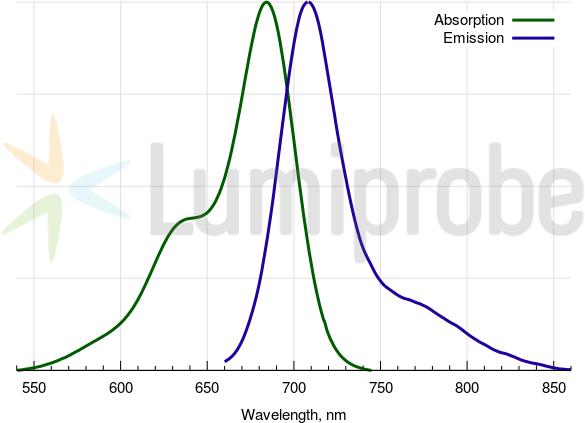Cyanine5.5 alkyne
| Cat. # | Quantity | Price | Lead time | Buy this product |
|---|---|---|---|---|
| A70B0 | 1 mg |
$125
|
in stock | |
| B70B0 | 5 mg |
$260
|
in stock | |
| C70B0 | 10 mg |
$325
|
in stock | |
| D70B0 | 25 mg |
$510
|
in stock | |
| E70B0 | 50 mg |
$895
|
in stock | |
| F70B0 | 100 mg |
$1490
|
in stock |

Far red / near-infrared dye alkyne for сlick сhemistry labeling. Cyanine5.5 is an analog of Cy5.5®, a popular fluorophore widely used for various applications, including intact organism imaging. This reagent can be conjugated with azido groups under mild copper-catalyzed сlick сhemistry conditions.
This reagent is soluble in organic solvents, but mixtures of water with a small percent of DMSO can be used for efficient conjugation. Cyanine5.5 alkyne can also be used for the labeling of small molecules with this far red/NIR dye.
Absorbance and emission spectra of Cyanine5.5

Recommended protocol
Calculator
Customers also purchased with this product
Cyanine3 azide
Azide derivative of Cyanine3 fluorescent dye for сlick сhemistry.Cyanine7 carboxylic acid
The unactivated free carboxylic acid of near-infrared fluorescent dye Cyanine7.BDP® 630/650 lipid stain
Far-red fluorescent dye BDP 630/650 for staining of lipids and and other lipophilic compounds.General properties
| Appearance: | dark blue powder |
| Molecular weight: | 656.30 |
| CAS number: | 1628790-37-3 |
| Molecular formula: | C43H46ClN3O |
| Solubility: | good in organic solvents (DMF, DMSO, acetonitrile, DCM, alcohols), practically insoluble in water (5.2 uM, 3.7 mg/L) |
| Quality control: | NMR 1H, HPLC-MS (95%) |
| Storage conditions: | Storage: 24 months after receival at -20°C in the dark. Transportation: at room temperature for up to 3 weeks. Avoid prolonged exposure to light. |
| MSDS: | Download |
| Product specifications |
Spectral properties
| Excitation/absorption maximum, nm: | 684 |
| ε, L⋅mol−1⋅cm−1: | 198000 |
| Emission maximum, nm: | 710 |
| Fluorescence quantum yield: | 0.2 |
| CF260: | 0.07 |
| CF280: | 0.03 |
Product citations
- Agnes, R.S.; Traughber, B.J.; Muzic, R.F. Development of a selective novel fluorescent substrate for sodium-dependent transporters. Life sciences, 2024, 351, 122847. doi: 10.1016/j.lfs.2024.122847
- Arranz-Gibert, P.; Vanderschuren, K.; Haimovich, A.; Halder, A.; Gupta, K.; Rinehart, J.; Isaacs, F. J. Chemoselective Restoration of Para-Azido-Phenylalanine at Multiple Sites in Proteins. Cell Chemical Biology, 2022, 29(6), 1046-1052.e4. doi: 10.1016/j.chembiol.2021.12.002
- Li, M.; Ruwe, H.; Melzer, M.; Junker, A.; Hensel, G.; Tschiersch, H.; Schwenkert, S.; Chamas, S.; Schmitz-Linneweber, C.; Börner, T.; Stein, N. The Arabidopsis AAC Proteins CIL and CIA2 Are Sub-functionalized Paralogs Involved in Chloroplast Development. Frontiers in Plant Science, 2021, 12, 681375. doi: 10.3389/fpls.2021.681375
- Li, M.; Hensel, G.; Melzer, M.; Junker, A.; Tschiersch, H.; Ruwe, H.; Arend, D.; Kumlehn, J.; Börner, T.; Stein, N. Mutation of the ALBOSTRIANS Ohnologous Gene HvCMF3 Impairs Chloroplast Development and Thylakoid Architecture in Barley. Frontiers in Plant Science, 2021, 12, 732608. doi: 10.3389/fpls.2021.732608













 $
$ 
